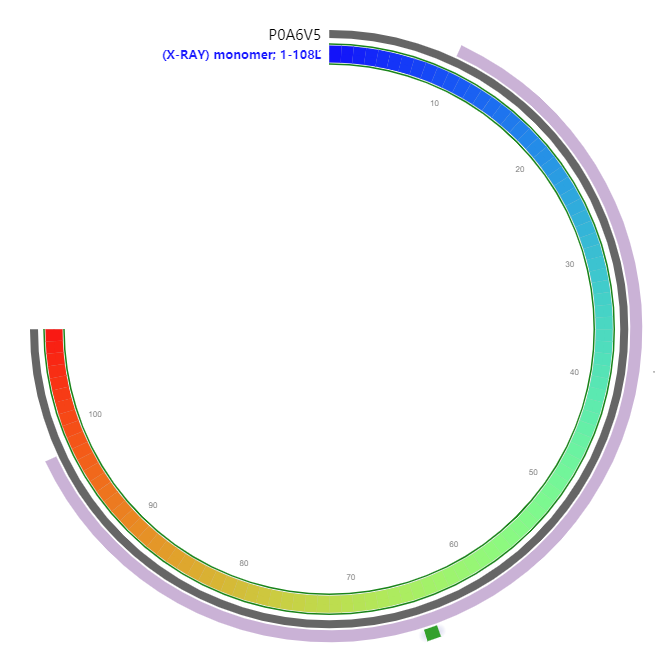Catalyzes, although with low efficiency, the sulfur transfer reaction from thiosulfate to cyanide. hydrogen cyanide + thiosulfate = 2 H+ + sulfite + thiocyanate
MDQFECINVADAHQKLQEKEAVLVDIRDPQSFAMGHAVQAFHLTNDTLGAFMRDNDFDTP
VMVMCYHGNSSKGAAQYLLQQGYDVVYSIDGGFEAWQRQFPAEVAYGA
110

| PMID | Title & Author | Abstract | Year | |
| 0 | 1846566 | Regulation of glpD and glpE gene expression by a cyclic AMP-cAMP receptor protein (cAMP-CRP) complex in Escherichia coli.Y L Choi , S Kawase, M Kawamukai, H Sakai, T Komano | The glpE gene of E. coli was found to be transcribed divergently with respect to glpD, which is adjacent to glpE head-to-head on the E. coli chromosome. We constructed glpD- and/or glpE-lacZ fusion plasmids, which provided glpD and lacZ as reporter genes. The expression of glpD and glpE, under the control of the cAMP-CRP complex, was examined by measuring the activities in E. coli cells of beta-galactosidase encoded by lacZ and glycerol-3-phosphate dehydrogenase encoded by glpD. In the double-reporter-gene system, the expression of glpD and glpE was found to be positively regulated by cAMP-CRP. We also confirmed that intracellular levels of the translation products and the transcripts from glpD and glpE were positively regulated by cAMP-CRP. The cAMP-mediated induction of gene expression of glpD and glpE was significantly affected by structural alterations of the single CRP-binding site between glpD and glpE. These results indicate that the single CRP-binding site is a cis-acting element involved in the positive regulation of the expression of both glpD and glpE at the transcriptional level. | 1991 |
| 1 | 10735872 | Characterization of a 12-kilodalton rhodanese encoded by glpE of Escherichia coli and its interaction with thioredoxin.Ray WK, Zeng G, Potters MB, Mansuri AM, Larson TJ | Rhodaneses catalyze the transfer of the sulfane sulfur from thiosulfate or thiosulfonates to thiophilic acceptors such as cyanide and dithiols. In this work, we define for the first time the gene, and hence the amino acid sequence, of a 12-kDa rhodanese from Escherichia coli. Well-characterized rhodaneses are comprised of two structurally similar ca. 15-kDa domains. Hence, it is thought that duplication of an ancestral rhodanese gene gave rise to the genes that encode the two-domain rhodaneses. The glpE gene, a member of the sn-glycerol 3-phosphate (glp) regulon of E. coli, encodes the 12-kDa rhodanese. As for other characterized rhodaneses, kinetic analysis revealed that catalysis by purified GlpE occurs by way of an enzyme-sulfur intermediate utilizing a double-displacement mechanism requiring an active-site cysteine. The K(m)s for SSO(3)(2-) and CN(-) were 78 and 17 mM, respectively. The apparent molecular mass of GlpE under nondenaturing conditions was 22.5 kDa, indicating that GlpE functions as a dimer. GlpE exhibited a k(cat) of 230 s(-1). Thioredoxin 1 from E. coli, a small multifunctional dithiol protein, served as a sulfur acceptor substrate for GlpE with an apparent K(m) of 34 microM when thiosulfate was near its K(m), suggesting that thioredoxin 1 or related dithiol proteins could be physiological substrates for sulfurtransferases. The overall degree of amino acid sequence identity between GlpE and the active-site domain of mammalian rhodaneses is limited ( approximately 17%). This work is significant because it begins to reveal the variation in amino acid sequences present in the sulfurtransferases. GlpE is the first among the 41 proteins in COG0607 (rhodanese-related sulfurtransferases) of the database Clusters of Orthologous Groups of proteins (http://www.ncbi.nlm.nih.gov/COG/) for which sulfurtransferase activity has been confirmed. | 2000 |
| 2 | 11709175 | Escherichia coli GlpE is a prototype sulfurtransferase for the single-domain rhodanese homology superfamily.Spallarossa A, Donahue JL, Larson TJ, Bolognesi M, Bordo D | Background: Rhodanese domains are structural modules occurring in the three major evolutionary phyla. They are found as single-domain proteins, as tandemly repeated modules in which the C-terminal domain only bears the properly structured active site, or as members of multidomain proteins. Although in vitro assays show sulfurtransferase or phosphatase activity associated with rhodanese or rhodanese-like domains, specific biological roles for most members of this homology superfamily have not been established. Results: Eight ORFs coding for proteins consisting of (or containing) a rhodanese domain bearing the potentially catalytic Cys have been identified in the Escherichia coli K-12 genome. One of these codes for the 12-kDa protein GlpE, a member of the sn-glycerol 3-phosphate (glp) regulon. The crystal structure of GlpE, reported here at 1.06 A resolution, displays alpha/beta topology based on five beta strands and five alpha helices. The GlpE catalytic Cys residue is persulfurated and enclosed in a structurally conserved 5-residue loop in a region of positive electrostatic field. Conclusions: Relative to the two-domain rhodanese enzymes of known three-dimensional structure, GlpE displays substantial shortening of loops connecting alpha helices and beta sheets, resulting in radical conformational changes surrounding the active site. As a consequence, GlpE is structurally more similar to Cdc25 phosphatases than to bovine or Azotobacter vinelandii rhodaneses. Sequence searches through completed genomes indicate that GlpE can be considered to be the prototype structure for the ubiquitous single-domain rhodanese module. | 2001 |
Spallarossa A , Donahue J L , Larson T J , et al. Escherichia coli, GlpE Is a Prototype Sulfurtransferase for the Single-Domain Rhodanese Homology Superfamily[J]. Structure, 2001, 9(11):1117-1125.